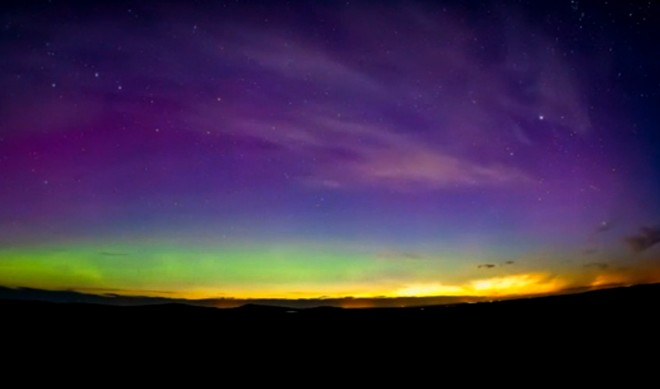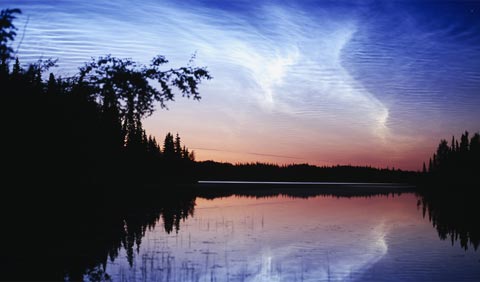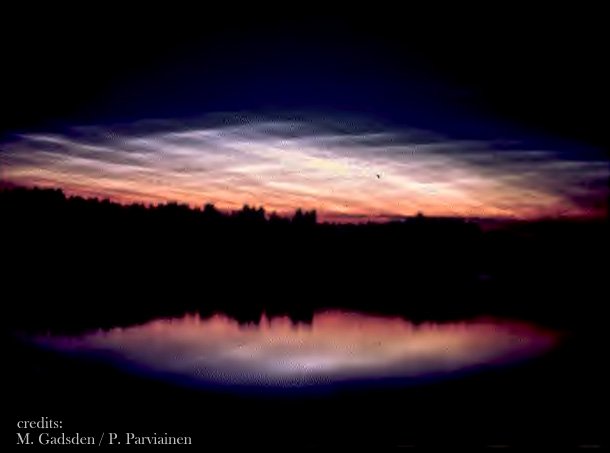Explain the amazing characteristics of luminous clouds
A plasma physicist from the California Institute of Technology (Caltech) finally found the answer to the strange characteristics of noctilucent clouds, ending decades of mystery. Noctilucent clouds are thin, thin clouds of clouds flying at an altitude of 85 km.
The mystery of noctilucent clouds
Noctilucent cloud ('noctilucent cloud' or 'night-shining cloud') was first described in 1885, two years after the volcanic eruption of Krakatoa Island (Indonesia). The volcano had sprayed a bunch of ash and debris into the Earth's atmosphere reaching an altitude of 80km. This event has affected global climate and weather for many years and probably created the first luminous clouds.

The impact of Krakatoa's volcanic eruption gradually disappeared, but the unusually green charged clouds remained. They nestled in the thin middle layer of the Earth - this is the upper atmosphere with a pressure of less than 10,000 times the pressure in the sea.
Noctilucent clouds can be seen at dusk, they appear most often in the summer months from 50 to 70 degrees north and south, although in recent years they have appeared in southern regions like Utah and Colorado.
Noctilucent clouds are a phenomenon that occurs in the summer because the atmosphere at an altitude of 85 km is coldest in the summer, accelerating the formation of ice particles creating clouds.

Paul M. Bellan, professor of applied physics at Caltech, said: 'The range of noctilucent clouds seems to be increasing, perhaps because the global climate is getting warmer.'
According to researchers at Poker Flat (Alaska), 25 years ago they discovered that the cloud reflected strongly with radar. This unusual feature has long been a concern for scientists. Published in the August issue of the Journal of Geophysical Research-Atmospheres, the Ballen finally has an explanation: ice particles in noctilucent clouds are covered by a thin layer of metal with components including sodium and iron. The metal membrane has caused radar waves to ripple in the cloud like a phenomenon of X-rays reflected from a crystal lattice.

What is luminous cloud?- The polar clouds in the middle floor.They are very familiar to the observers of the noctilucent cloud.Because they are at high altitudes, close to the boundary with space, the noctilucent clouds often glow at night when sunlight hits them below and the atmosphere is dark.(Photo: ufoarea)
Sodium and iron atoms are collected in the upper atmosphere after the supernova shooting in the sky. These metal atoms settle in a thin layer of vapor just above the altitude where the luminous cloud occurs. Astronomers have recently used the sodium layer to create artificial guide stars illuminated by lasers for an adaptive optical telescope to eliminate the turbulence effect of the atmosphere to obtain photos of the sky are clearer.

Measures to determine the density of the vapor layers with sodium and iron atoms show that metallic steam decreases by up to 80% when there is a luminous cloud present.
Bellan said: ' Noctilucent clouds are like a fly trap for sodium and iron atoms'. Through laboratory experiments, other researchers also discovered that at cold temperatures (-123 degrees Celsius) inside the noctilucent cloud, atoms in sodium vapor will rapidly condense. re-on the tape surface to form metal film.
He said: ' If there are metallic ice particles in the luminous cloud, radar will react very strongly. This phenomenon is not a combination of reactions to individual ice particles. In fact, ice particles do not cause such a strong reaction. The key is that the wavy lines of the cloud containing metal-coated ice particles reflect together and reinforce each other, this phenomenon is like a parade going through the bridge and causing the bridge to shake '. .
- Watch the clouds with strange shapes
- Very strange, poisonous scales
- Virtual clouds appear suddenly in the sky of Australia
- Amazing phenomenon: Rainbow clouds appear on Mount Everest
- Explain the
- Terrifying foreboding of strange clouds
- Noctilucent clouds in the Antarctic sky
- Only watching flying clouds can predict the danger of weather
- The new finding may help explain why the T-Rex dinosaur has very small arms
- French people stunned because of rotten clouds
- why do clouds have a lot of colors?
- Video: Giant scroll clouds across the Pacific Ocean
 Is the magnetic North Pole shift dangerous to humanity?
Is the magnetic North Pole shift dangerous to humanity? Washington legalizes the recycling of human bodies into fertilizer
Washington legalizes the recycling of human bodies into fertilizer Lightning stone - the mysterious guest
Lightning stone - the mysterious guest Stunned by the mysterious sunset, strange appearance
Stunned by the mysterious sunset, strange appearance Strange cloud looks like 'alien mother ship', why should we take shelter immediately?
Strange cloud looks like 'alien mother ship', why should we take shelter immediately?  The Real Cause Behind Global Warming
The Real Cause Behind Global Warming  Clouds like flying saucers on top of Chua Chan mountain
Clouds like flying saucers on top of Chua Chan mountain  Doomsday Clouds Appear Over Canada: Could This Be The Last Time We See Them?
Doomsday Clouds Appear Over Canada: Could This Be The Last Time We See Them?  Successfully launched the EarthCARE satellite to probe the impact of clouds on climate
Successfully launched the EarthCARE satellite to probe the impact of clouds on climate  Decoding where the cleanest air on the planet is
Decoding where the cleanest air on the planet is 